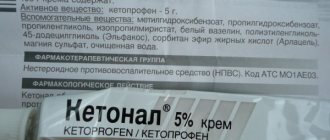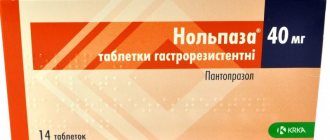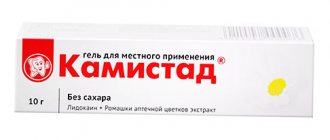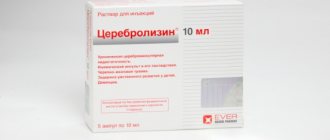Pharmacological properties of the drug Voltaren emulgel
Diclofenac is an NSAID with pronounced antirheumatic, anti-inflammatory, analgesic and antipyretic effects. The main mechanism of its action is to suppress the biosynthesis of prostaglandins. The use of Voltaren Emulgel for inflammation caused by injury or rheumatic disease leads to a reduction in tissue swelling, pain and promotes rapid restoration of the functions of damaged joints, ligaments, tendons and muscles. Thanks to its water-alcohol base, the drug also has a local anesthetic and cooling effect. The amount of diclofenac resorbed through the skin is proportional to the area to which it is applied, and also depends on the total dose of the drug and the degree of skin hydration. After topical application of 2.5 g of Voltaren Emulgel to a skin surface area of 500 cm2, the absorption of diclofenac is approximately 6%. The use of an occlusive dressing for 10 hours leads to a threefold increase in the resorption of diclofenac. After applying Voltaren Emulgel to the skin of the joints of the hand and knee, diclofenac is determined in the blood plasma (its maximum concentration is approximately 100 times lower than after oral administration), synovial membrane and synovial fluid. The binding of diclofenac to plasma proteins (mainly albumin) is 99.7%. Diclofenac is metabolized primarily by hydroxylation to form several derivatives, two of which are pharmacologically active, but to a significantly lesser extent than diclofenac. Diclofenac and its metabolites are excreted primarily in the urine. The total systemic clearance of diclofenac in blood plasma averages 263±56 ml/min, and the final half-life is 1–3 hours. In patients with kidney disease, accumulation of diclofenac and its metabolites was not observed. In patients with chronic hepatitis or compensated liver cirrhosis, the pharmacokinetics and metabolism of diclofenac do not change.
Release form and composition
Voltaren is available in the form of tablets, solution for intramuscular injection,
rectal suppository, patch, spray for external use.
The main active component of all dosage forms of Voltaren is diclofenac sodium, its content is:
- A yellow enteric-coated tablet with “CG” engraved on one of the convex surfaces, “BZ” on the other - 25 mg and a light brown tablet with “CG” and “GT” embossed on both sides - 50 mg;
- Extended-release tablet, pink film-coated with black markings on one of the convex sides “CG”, on the other “CGC” - 100 mg;
- Ampoule with solution for injection – 75 mg;
- Suppositories – 25 mg, 50 mg, 100 mg;
- Adhesive layer on the surface of the patch – 15 mg, 30 mg;
- The spray dose is 8 mg.
Excipients in the composition:
- Voltaren tablets, enteric-coated - microcrystalline cellulose, corn starch, colloidal anhydrous silicon dioxide, lactose monohydrate, magnesium stearate, povidone K30, sodium carboxymethyl starch;
- Long-acting tablets – magnesium stearate, anhydrous colloidal silicon dioxide, sucrose, cetyl alcohol, povidone;
- Solution – mannitol, distilled propylene glycol, benzyl alcohol, sodium bisulfite, sodium hydroxide for injection, water for injection;
- Rectal suppositories – hard fat;
- Voltaren patch - levomenthol, methylpyrrolidone, propylene glycol esters of fatty acids, citric acid, isoprene styrene copolymer, polyisobutylene, esterified gum, mercaptobenzimidazole, butylated hydroxytoluene, liquid paraffin;
- Spray - propylene glycol, isopropanol, soy lecithin, ethanol, sodium dihydrogen phosphate dihydrate, sodium hydrogen phosphate dodecahydrate, disodium edetate, peppermint leaf oil, ascorbyl palmitate, water.
Indications for use of the drug Voltaren emulgel
Symptomatic treatment of pain, inflammation and swelling in:
- soft tissue damage: injuries to tendons, ligaments, muscles and joints (for example due to dislocation, sprain, hematoma); sports injuries;
- localized forms of rheumatic diseases of soft tissues: tendonitis including tennis elbow, bursitis, shoulder-hand syndrome, periarthritis;
Reviews ↑
Alexander, 44 years old:
For a long time nothing helped me with arthritis until the doctor prescribed the drug Voltaren, first in injections and later in tablets. He explained that this drug will not only relieve pain, like many drugs, but also relieve inflammation from the joint. Thanks to Voltaren, I forgot about the pain.
Irina, 37 years old:
Many painkillers only relieve symptoms, and treatment for sore joints or back requires Voltaren. I fully support Alexander, the drug is effective. It was this remedy that helped me forget about joint problems and back pain for a long time! By the way, these injections were prescribed to me by a doctor from one of the best clinics in Moscow.
Use of the drug Voltaren emulgel
For adults and children over the age of 12 years, Voltaren Emulgel is used 3-4 times a day, lightly rubbing into the skin. The amount of the drug used depends on the size of the painful area, for example, 2–4 g of Voltaren Emulgel (which is comparable in volume to the size of a cherry or walnut) is enough to apply to an area of 400–800 cm2. After applying the drug, you must wash your hands (except for those cases when the application is carried out on this area). The duration of treatment depends on the performance and effectiveness of therapy. Indications for continued therapy are recommended to be reviewed every 2 weeks. The drug should not be used for more than 14 days in a row for soft tissue lesions or rheumatic soft tissue disease, and for more than 21 days in case of pain due to arthritis (unless the doctor has prescribed a different treatment regimen). If no positive clinical dynamics are noted within 7 days or the condition worsens, you should consult a doctor. Elderly patients do not require dosage adjustment.
Frequently asked questions ↑
How to give an injection correctly?
intramuscularly into the upper right or left quadrant of the gluteal region as deeply as possible so as not to damage the nerves located in this area. The next injection is made in another gluteal area.
Video: how to give injections correctly
When administered intravenously, one ampoule of the drug takes one hundred milliliters of a five percent dextrose solution or saline solution. To dilute the contents of the drug ampoule, add 0.5 ml of sodium bicarbonate to it.
The dropper is placed for a period of half an hour to three hours (depending on the severity of the pain).
In the postoperative period, a powerful dose is used in a short time. During the first period of fifteen to sixty minutes, twenty-five to fifty mg of voltaren is administered.
Then the rate of administration decreases until the total amount of solution containing voltaren reaches 150 mg.
To avoid the development of complications, intravenous infusions of Voltaren should be performed in a medical facility.
Is the injection painful?
The pain of a Voltaren injection does not exceed the pain from any intramuscular injection.
Is it allowed to drink alcohol?
Alcohol should not be taken during treatment with Voltaren injections due to an increased risk of side effects on the digestive system and urinary tract.
Side effects of the drug Voltaren emulgel
Voltaren Emulgel is usually well tolerated. Adverse reactions include mild transient reactions on the skin at the site of application. In rare cases, allergic reactions have occurred. Infections and infestations: very rarely - pustular rashes. From the immune system: very rarely - hypersensitivity reactions, angioedema. From the respiratory system: very rarely - bronchial asthma. From the skin and connective tissue: often - rashes, erythema, eczema, dermatitis, including contact; rarely - bullous dermatitis; very rarely - photosensitivity reactions, itching, burning sensation of the skin.
Injection solution
If you have back pain, severe migraine attacks and other conditions, it is recommended to take Voltaren in the form of injections. The injections are administered intramuscularly (into the gluteal muscle), the injections are deep. It is not recommended to use the drug for more than two days in a row; therapy can then be replaced by taking tablets or rectal suppositories.
The standard dose is 75 mg once a day, this is one ampoule. In especially difficult cases, it is allowed to give injections twice a day, 75 mg, the interval between injections is 2 hours or more, the second injection is placed in the opposite gluteal region. The total total dose per day should not exceed 150 mg.
For severe migraine attacks, 75 mg is prescribed by injection; the drug should be administered as early as possible to have the desired effect. In some cases, it is possible to introduce suppositories up to 100 mg on the same day. The total daily dose on the first day should not exceed 175 mg.
Special instructions for the use of the drug Voltaren emulgel
The likelihood of developing systemic side effects with topical use of diclofenac compared to its oral administration is low, but increases when Voltaren Emulgel is applied to relatively large surfaces of the skin for a long time. Voltaren Emulgel is recommended to be applied only to intact areas of the skin, avoiding contact with damaged, inflamed or infected areas and open wounds. It should not come into contact with the eyes or other mucous membranes. The drug cannot be taken orally. If any skin rash appears, treatment with the drug should be discontinued. Voltaren Emulgel should not be used under a waterproof occlusive dressing. In the case of a sprain, a bandage may be applied to the affected area. Voltaren Emulgel contains propylene glycol, which may cause mild local skin irritation in some patients. During pregnancy and breastfeeding . Since clinical experience with the use of the drug in pregnant or breastfeeding women is limited, it is not recommended for use during pregnancy and breastfeeding. This especially applies to the third trimester of pregnancy due to the likely effect on the contractility of the myometrium and the possibility of developing weakness of labor and/or premature closure of the ductus arteriosus. Animal studies have not revealed evidence of a negative effect on pregnancy, fetal development, childbirth or postnatal development. If it is absolutely necessary to use the drug during breastfeeding, when the expected benefit outweighs the potential risk, the drug should not be applied to the chest area or to a large surface of the skin, and should not be used for a long time. Impact on the ability to drive vehicles and operate machinery. Does not affect. Children. Voltaren Emulgel is not recommended for use in children under 12 years of age.
Contraindications
According to the instructions, Voltaren is contraindicated in the following cases:
- Hypersensitivity to diclofenac sodium or auxiliary components of the drug, intolerance to analgin;
- Stomach or duodenal ulcer, Crohn's disease, colitis, gastritis;
- Children under 6 years of age (for all dosage forms);
- Children under 14 years of age (for Voltaren Retard tablets);
- Unexplained disturbances in the functioning of the hematopoietic system;
- Pregnancy 3rd trimester;
- Breast-feeding;
- Severe disorders of the cardiovascular system, kidneys and liver;
- Hemorrhoids, proctitis, bleeding from the rectum (for rectal suppositories).
Voltaren is prescribed with caution to patients:
- Old age with underweight;
- Who in the past had a stomach and duodenal ulcer;
- With hemostasis disorders;
- With a history of gastrointestinal bleeding.









